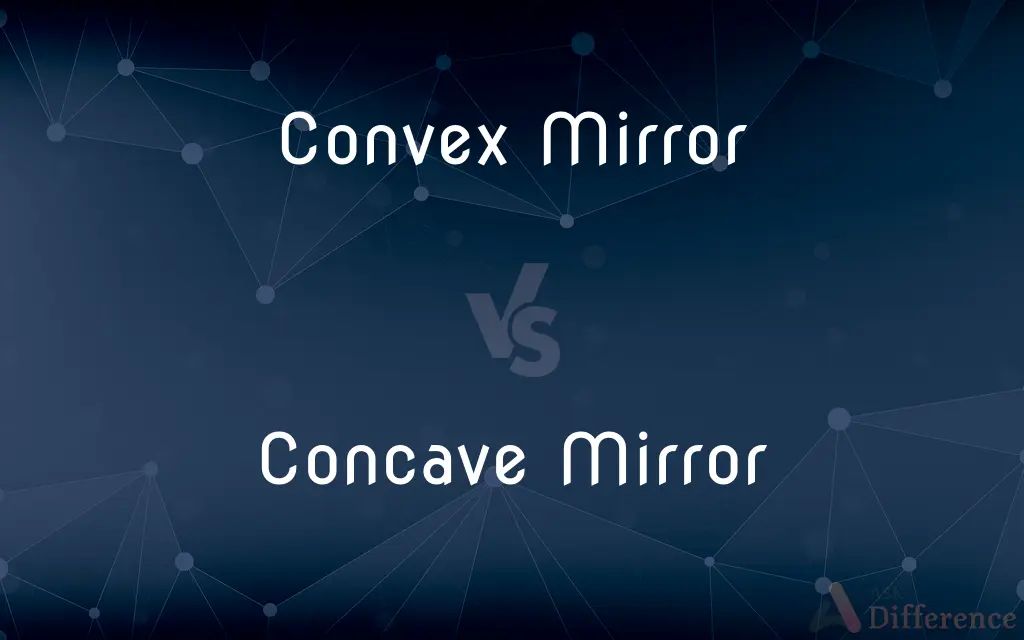Convex Mirror vs. Concave Mirror — What's the Difference?
By Tayyaba Rehman — Published on January 16, 2024
Convex mirrors bulge outwards; concave mirrors curve inwards.

Difference Between Convex Mirror and Concave Mirror
Table of Contents
ADVERTISEMENT
Key Differences
A convex mirror, being outwardly curved, spreads light out, giving a wider field of view. It often has applications in security and vehicle side mirrors. Conversely, a concave mirror, with its inward curve, concentrates light, producing a magnified image. Found in telescopes and shaving mirrors, the concave mirror offers a detailed view of objects up close.
Convex mirrors create a diminished, virtual, and erect image of objects, making them useful for providing broad overviews. On the other hand, concave mirrors can produce both real and virtual images depending on the object's position relative to the mirror's focal point.
In terms of safety and practicality, convex mirrors provide a panoramic view, making them essential for blind-spot detection in vehicles. Concave mirrors, given their ability to magnify, assist in tasks requiring detailed inspection, like applying makeup or shaving.
The focal length of a convex mirror is always positive, considering the focal point is behind the mirror. For a concave mirror, the focal length is negative, as its focal point lies in front of the mirror itself.
In optics, the convex mirror tends to diverge light rays, making them spread out. The concave mirror, in contrast, converges light rays, causing them to meet at a specific point.
ADVERTISEMENT
Comparison Chart
Shape
Bulges outwards
Curves inwards
Image Formation
Diminished, virtual, and erect
Can be magnified, real or virtual
Common Uses
Security, vehicle side mirrors
Telescopes, shaving mirrors
Focal Length
Positive
Negative
Light Behavior
Diverges light rays
Converges light rays
Compare with Definitions
Convex Mirror
A mirror with an outwardly bulging reflective surface.
The store uses a convex mirror for wide-angle surveillance.
Concave Mirror
A reflective surface with a negative focal length.
The focal point of the concave mirror lies in front of its surface.
Convex Mirror
An optical element that forms a virtual, erect, and diminished image.
The parking lot uses convex mirrors for a broader view of incoming traffic.
Concave Mirror
A mirror with an inwardly curving reflective surface.
Astronomers use concave mirrors in their telescopes for clear images of distant stars.
Convex Mirror
A curved mirror that diverges light rays.
Cars have convex mirrors to cover blind spots.
Concave Mirror
An optical element that can magnify objects.
The dentist uses a concave mirror to inspect teeth closely.
Convex Mirror
A reflective surface with a positive focal length.
The convex mirror's focal point lies behind its surface.
Concave Mirror
Commonly found in applications requiring detailed view.
The makeup artist prefers a concave mirror for precise application.
Convex Mirror
Widely used in safety and surveillance applications.
The convenience store positioned a convex mirror at its entrance.
Concave Mirror
A curved mirror that converges light rays.
The flashlight uses a concave mirror to focus its beam.
Common Curiosities
Where are convex mirrors commonly used?
Convex mirrors are often used in security applications and as vehicle side mirrors.
What is a typical use of a concave mirror?
Concave mirrors are commonly used in telescopes and for close-up tasks like shaving.
What's the primary shape difference between a convex mirror and a concave mirror?
Convex mirrors bulge outwards; concave mirrors curve inwards.
Which mirror diverges light rays?
Convex mirrors diverge light rays.
What about the focal length of a concave mirror?
The focal length of a concave mirror is negative.
Why do makeup artists often use concave mirrors?
Concave mirrors offer a magnified view, ideal for detailed tasks like makeup application.
Which mirror converges light rays?
Concave mirrors converge light rays.
Is the focal length of a convex mirror positive or negative?
The focal length of a convex mirror is positive.
How do convex and concave mirrors differ in image formation?
Convex mirrors form a diminished, virtual, and erect image, while concave mirrors can produce magnified, real or virtual images.
Why are convex mirrors preferred in vehicles?
Convex mirrors provide a wider field of view, helping detect blind spots.
Are the images formed by convex mirrors always virtual?
Yes, convex mirrors always form virtual, erect, and diminished images.
Can concave mirrors form both real and virtual images?
Yes, depending on the object's position relative to the mirror's focal point.
How does a convex mirror's focal point position compare to a concave mirror's?
The focal point of a convex mirror is behind the mirror, while for a concave mirror, it's in front.
Which mirror is used in satellite dishes to focus signals?
Concave mirrors are used in satellite dishes.
How do convex and concave mirrors affect the parallel rays of light?
Convex mirrors make parallel rays diverge, while concave mirrors make them converge.
Share Your Discovery

Previous Comparison
Imax 2D vs. Digital Cinema
Next Comparison
I5 vs. I7Author Spotlight
Written by
Tayyaba RehmanTayyaba Rehman is a distinguished writer, currently serving as a primary contributor to askdifference.com. As a researcher in semantics and etymology, Tayyaba's passion for the complexity of languages and their distinctions has found a perfect home on the platform. Tayyaba delves into the intricacies of language, distinguishing between commonly confused words and phrases, thereby providing clarity for readers worldwide.












































